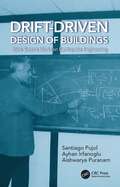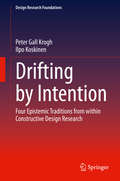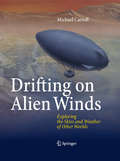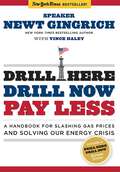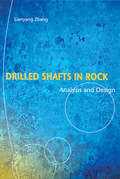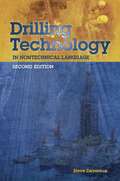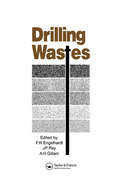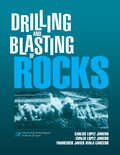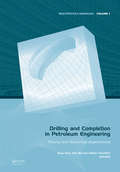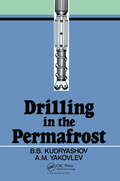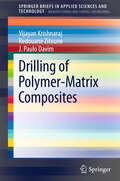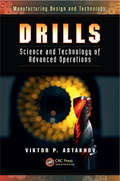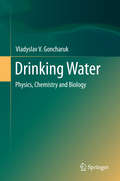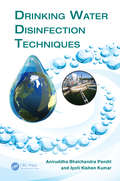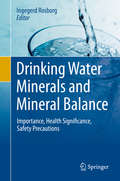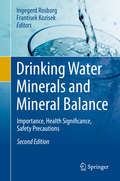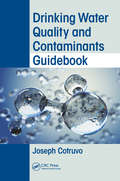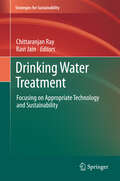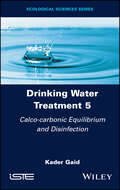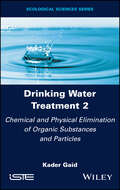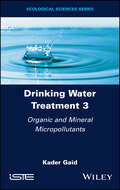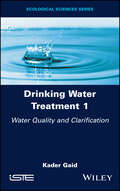- Table View
- List View
Drift-Driven Design of Buildings: Mete Sozen’s Works on Earthquake Engineering
by Santiago Pujol Ayhan Irfanoglu Aishwarya PuranamThis book summarizes the most essential concepts that every engineer designing a new building or evaluating an existing structure should consider in order to control the damage caused by drift (deformation) induced by earthquakes. It presents the work on earthquake engineering done by Dr. Mete Sozen and dozens of his collaborators and students over decades of experimentation, analysis, and reconnaissance. Many of the concepts produced through this work are integral part of earthquake engineering today. Nevertheless, the connection between the concepts in use today and the original sources is not always explained. Drift-Driven Design of Buildings summarizes Sozen's research, provides common language and notation from subject to subject, provides examples and supporting data, and adds historical context as well as class notes that were the result of Sozen’s dedication to teaching. It distills reinforced concrete building design to resist earthquake demands to its essence in a way that no other available book does. The recommendations provided are not only essential but also of the utmost simplicity which is not the result of uninformed neglect of relevant parameters but rather the result of careful consideration and selection of parameters to retain only those that are most critical. Features: Provides the reader with a clear understanding of the essential features that control the seismic response of RC buildings Describes a simple (perhaps the simplest) seismic design method available Includes the underlying hard data to support and explain the methods described Presents decades of work by one of the most prolific and brilliant civil engineers in the United States in the second half of the 20th century Drift-Driven Design of Buildings serves as a useful guide for civil and structural engineering students for self-study or in-class learning, as well as instructors and practicing engineers.
Drifting by Intention: Four Epistemic Traditions from within Constructive Design Research (Design Research Foundations)
by Peter Gall Krogh Ilpo KoskinenConstructive design research, is an exploratory endeavor building exemplars, arguments, and evidence. In this monograph, it is shown how acts of designing builds relevance and articulates knowledge in combination. Using design acts to build new knowledge, invite reframing of questions and new perceptions to build up. Respecting the emergence of new knowledge in the process invite change of cause and action. The authors' term for this change is drifting; designers drift; and they drift intentionally, knowing what they do. The book details how drifting is a methodic practice of its own and provides examples of how and where it happens. This volume explores how to do it effectively, and how it depends on the concept of knowledge. The authors identify four epistemic traditions in constructive design research. By introducing a Knowledge/Relevance model they clarify how design experiments create knowledge and what kinds of challenges and contributions designers face when drifting. Along the lines of experimental design work the authors identify five main ways in which constructive experiments drift. Only one of them borrows its practices from experimental science, others build on precedents including arts and craft practices. As the book reveals, constructive design research builds on a rich body of research that finds its origins in some of the most important intellectual movements of 20th century. This background further expands constructive design research from a scientific model towards a more welcoming understanding of research and knowledge. This monograph provides novel actionable models for steering and navigating processes of constructive design research. It helps skill the design researcher in participating in the general language games of research and helps the design researcher build research relations beyond the discipline.
Drifting on Alien Winds
by Michael CarrollEver since the Montgolfier's hot air balloon carried a chicken, a goat, and a duck into the Parisian skies, scientists have dreamed of contraptions to explore the atmosphere. With the advent of the space age, new airborne inventions were needed. From the Soviet Venus balloons to the advanced studies of blimps and airplanes for the atmospheres of Mars and Titan, Drifting on Alien Winds surveys the many creative and often wacky ideas for exploring alien skies. Through historical photographs and stunning original paintings by the author, readers also explore the weather on planets and moons, from the simmering acid-laden winds of Venus to liquid methane-soaked skies of Titan.
Drill Here, Drill Now, Pay Less: A Handbook for Slashing Gas Prices and Solving Our Energy Crisis
by Newt Gingrich Vince HaleyNew York Times bestselling author, former Speaker of the House, and Fox News political analyst Newt Gingrich has a plan for slashing gas prices and reducing our long-term dependence on foreign oil.Gingrich is famous for taking big, visionary ideas and boiling them down into practical solutions as demonstrated in this year's earlier release, Real Change, which was on the New York Times bestseller list for eleven weeks. His new book Drill Here, Drill Now, Pay Less does just that. Dealing not only with spiraling gas prices, but with the energy crisis as a whole, Gingrich shows how we can safely reap the benefits of America's own natural resources and technology in gas, oil, coal, wind, solar, biofuels and nuclear energy.Gingrich argues that the pinch Americans are feeling at the pump is not a blip in the economy but a looming crisis--affecting not only the price of gas, but the price of food, the strength of our economy, and our national security.To meet this crisis, Gingrich lays out a national strategy that will tap America's scientists, engineers, and entrepreneurs, and require Congress to unlock our oil reserves and remove all the impediments and disincentives that unnecessary government regulation has put in the way of American energy independence. The energy crisis is solvable, as Newt Gingrich's plan makes clear. His handbook, Drill Here, Drill Now, Pay Less is sure to become the talk of the presidential campaign season.
Drilled Shafts in Rock: Analysis and Design
by Lianyang ZhangDrilled shafts in rock are widely used as foundations of heavy structures such as highway bridges and tall buildings. Although much has been learned about the analysis and design of drilled shafts in rock, all the major findings are published in the form of reports and articles in technical journals and conference proceedings. This book i
Drilling Down
by Joseph A. Tainter Tadeusz W. PatzekFor more than a century, oil has been the engine of growth for a society that delivers an unprecedented standard of living to many. We now take for granted that economic growth is good, necessary, and even inevitable, but also feel a sense of unease about the simultaneous growth of complexity in the processes and institutions that generate and manage that growth. As societies grow more complex through the bounty of cheap energy, they also confront problems that seem to increase in number and severity. In this era of fossil fuels, cheap energy and increasing complexity have been in a mutually-reinforcing spiral. The more energy we have and the more problems our societies confront, the more we grow complex and require still more energy. How did our demand for energy, our technological prowess, the resulting need for complex problem solving, and the end of easy oil conspire to make the Deepwater Horizon oil spill increasingly likely, if not inevitable? This book explains the real causal factors leading up to the worst environmental catastrophe in U.S. history, a disaster from which it will take decades to recover.
Drilling Technology in Nontechnical Language
by Steve DevereuxAuthor Steve Devereux has completely rewritten and updated this overview of onshore and offshore drilling operations and technology. He takes readers through the entire drilling process from basic drilling geology through managing drilling operations. The updated edition covers key management issues such as safety, the environment, costs, and regulations. A new chapter offers advice to those considering working in the industry. Drilling Technology in Nontechnical Language, 2nd Edition, is ideal for everyone interested in the drilling industry, including industry veterans, non-engineer industry professionals, and undergraduate petroleum engineering students. New to this edition: • New chapter on getting work in the drilling industry (including types of employers, service companies, and drilling-related job definitions) • New graphics to make concepts and equipment easier to understand • Explanations of newer drilling technologies • "Well Control" chapter carefully rewritten to cover issues surrounding the BP Macondo blowout
Drilling Wastes
by John R. Wilson Sarah SharplesProceedings of the 1988 International Conference on Drilling Wastes, Calgary, Alberta, Canada, 5-8 April 1988.
Drilling and Blasting of Rocks
by FranciscoJavier AyalaCarcedoRock breakage with explosives has existed since the seventeenth century when black powder came into use in mining. Since then it has progressed from the invention of dynamite to the use of heavy ANFO. During the past two decades, there have been numerous technical contributions which have brought a better understanding of rock fragmentation with explosives, an improvement in drilling equipment and a noticeable evolution in the development of new explosives and blasting accessories. The Geomining Technological Institute of Spain (ITCE), aware of this progress and of the importance which the breakage process has acquired in mining and civil engineering projects, has ordered the publication of Drilling and Blasting of Rocks. The purpose of this Handbook is to give basic knowledge of the drilling systems, the types of available explosives and the accessories and the parameters that intervene in blast designing, whether controllable or not; at the same time the objectives and contents contribute to improved safety in mining. The Handbook is meant for all professionals who are involved with explosives in mining operations and civil engineering projects, as well as for students of technical schools.
Drilling and Completion in Petroleum Engineering: Theory and Numerical Applications (Multiphysics Modeling)
by Xinpu Shen William Standifird Mao BaiModern petroleum and petrotechnical engineering is increasingly challenging due to the inherently scarce and decreasing number of global petroleum resources. Exploiting these resources efficiently will require researchers, scientists, engineers and other practitioners to develop innovative mathematical solutions to serve as basis for new asset deve
Drilling in the Permafrost: Russian Translations Series, volume 84
by B.B. Kudyashov A.M. YakovlevFirst published in 1991. This volume presents a brief description of the natural conditions of the permafrost regions, the properties of the permafrost and the processes occurring in it, the fundamentals of the heat transfer processes during drilling and the service temperature conditions of the tool. Methods and devices for cooling the flushing media, principles of quality control of flushing agents and the technology and commercial viability of their use during drilling in the permafrost have been considered. The main emphasis in this book is on the drilling technology which uses a variety of flushing agents. The text also includes a description of the technology of utilizing grouting solutions, the theory and practice of drilling with simultaneous freezing of weakly cohesive, moist ground as well as jdrilling holes in the ice-sheets of the circumpolar regions. This book is intended for engineers and technical personnel engaged in drilling for exploratory geological works.
Drilling of Polymer-Matrix Composites
by J. Paulo Davim Vijayan Krishnaraj Redouane ZitouneThis brief focus on drilling of polymer matrix composites for aerospace and defence applications. It gives an introduction to machining of polymer composites and discusses drilling as a processing of composites.
Drills: Science and Technology of Advanced Operations
by Viktor P. AstakhovIn a presentation that balances theory and practice, Drills: Science and Technology of Advanced Operations details the basic concepts, terminology, and essentials of drilling. The book addresses important issues in drilling operations, and provides help with the design of such operations. It debunks many old notions and beliefs while introducing sc
Drinking Water
by Vladyslav V. GoncharukThis book takes a broad and eclectic view of the water that all humanity depends upon, probing its role in human life and in the history of our planet, as well as surveying the latest scientific understanding of purification techniques and standards for the protection of water quality. The volume opens with a chapter on the role of drinking water in human life, which discusses the planet's water resources, the quality of drinking water, water and health, the advent of water quality standards, "Green" chemistry and more. The chapter concludes by discussing the relationship of the biosphere and human civilization. Chapter Two explores the unique properties of water, the role of water in the scenario of development on Earth. Also covered is the current understanding of the importance of the isotopic composition of water, in particular the ratio of protium to deuterium, which is fundamental to life. The third chapter is devoted to Water Clusters, examining the structure, properties and formation of clusters. Also covered here is theoretical research on the interaction of water clusters with ozone, the impact of temperature on water clusters and more. Chapter Four is devoted to drinking water and factors affecting its quality. Discussion includes ecological and hygienic classification of centralized drinking water supply sources, water quality requirements, and problems and potentialities of drinking water preparation. The author introduces a new concept for supplying the population with high-quality drinking water. The fifth chapter examines the peculiarities and problems of water decontamination, with sections on chlorination, ozonation, the bactericidal effects of ultrasound and ultraviolet rays and more. Chapter Six offers a thorough exploration of the theory, means and methods of bio testing as an evaluation method for the quality of drinking water. The final chapter discusses new state standards for drinking water, as well as requirements and methods of quality control. The concluding selection relates the urgent need to measure, evaluate and protect the quality of drinking water and describes a new state standard of drinking water quality.
Drinking Water Chemistry: A Laboratory Manual
by Barbara HauserWhether you are a new employee or seasoned professional you need easy access to the latest test methods, updated quality control procedures, and calculations at your fingertips. You need to perform analyses quickly and easily and troubleshoot problems as they arise. You need a resource that is not only informative, but also practical and easy to use. Drinking Water Chemistry: A Laboratory Manual fills this need.The book gives you a thorough overview of the most basic, and therefore important, laboratory topics such as:Laboratory Safety - dos and don'ts based on real experienceSampling - preservation techniques, online sampling, and record keepingLaboratory Instruments - practical use ranges, principles of operation, calibration, conditioning, useful life and replacement, common quality control issuesChemical Use - reagents, standards, indicators, purpose and use, chemical quality and properties, avoidance of contamination, molecular weight calculationsQuality Control - replicate analyses, spiked, split, and reference samples, percent recovery of standard, standard deviation, control charts, and everyday quality control measuresWeights and Concentrations - care and analytical balances, mathematical conversions among concentration units, dilutions and concentration changesThe remaining chapters cover test analysis including: reason for the test, type of sample taken, treatment plant control significance, expected range of results, appropriate quality control procedures, apparatus used, reagents, including function, concentration and instructions for preparation, procedural steps, calculations and notes on possible problems, and references. This is a working manual, meant to be kept by your side in the lab, not on the shelf in an office or library. You can bend it, you can lay it flat, you can take it anywhere you do your job. Useful and practical Drinking Water Chemistry: A Laboratory Manual provides the information you need to perform tests, understand the results, apply them to the determination of water quality before and after treatment, and troubleshoot any problems.
Drinking Water Disinfection Techniques
by Jyoti Kishen Kumar Aniruddha Bhalchandra PanditWater is our natural heritage, our miracle of life. However, our increasingly technological society has become indifferent to water. Far from being pure, modern drinking water around the world contains many undesirable chemical and bacterial contaminants. The existing techniques employed for the disinfection of water are either energy-intensive or
Drinking Water Minerals and Mineral Balance
by Ingegerd RosborgThe various safety organizations working on drinking water all warn about unhealthy constituents, as well as elements that can cause corrosion or scaling on pipes and installations. However, drinking water may also provide a substantial portion of the daily mineral intake, especially for the elderly and children, or those at risk of deficiencies due to unhealthy eating habits or starvation. Thus, a holistic approach to drinking water is presented in this book and the scope is extended from standards for undesirable substances to the basic mineral composition of water, examining 22 nutrient elements and ions and 21 toxic substances. The function of the nutrients in the body, symptoms of deficiency and overload, and advantages of the minerals from drinking water are presented, as well as symptoms of toxic elements from drinking water. The authors also suggest healthy ranges of minerals and mineral ratios for drinking water. The book offers a valuable resource for the health evaluation of drinking waters, for private well owners, public water producers and safety organizations alike.
Drinking Water Minerals and Mineral Balance: Importance, Health Significance, Safety Precautions
by Ingegerd Rosborg Frantisek KozisekFollowing the successful first edition of this book on drinking water quality and health, this new edition puts more focus on the importance of minerals in drinking water. It includes new scientific material and presents additional studies on the negative health effects of reverse osmosis water. The various safety organizations working on drinking water all warn about unhealthy constituents, as well as elements that can cause corrosion or scaling on pipes and installations. However, drinking water may also provide a substantial portion of the daily mineral intake, especially for the elderly and children, or those at risk of deficiencies due to unhealthy eating habits or starvation. Thus, a holistic approach to drinking water is presented in this book and the scope is extended from standards for undesirable substances to the basic mineral composition of water, examining 22 nutrient elements and ions and 21 toxic substances. The function of the nutrients in the body, symptoms of deficiency and overload, and advantages of the minerals from drinking water are presented, as well as symptoms of toxic elements from drinking water. The authors also suggest healthy ranges of minerals and mineral ratios for drinking water. The book offers a valuable resource for the health evaluation of drinking waters, for private well owners, public water producers and safety organizations alike.
Drinking Water Quality and Contaminants Guidebook
by Joseph CotruvoK347191 BCC Drinking water quality is a sensitive issue, and the public is constantly barraged by contaminant reports now routinely at parts-per-trillion. Protection from microbial disease risks from drinking water must always be predominant; trace chemicals usually fall farther down the scale of possible health risks, but even negligible detections raise public concerns. Drinking Water Quality and Contaminants Guidebook presents information and guidance on drinking water quality and regulatory issues reflecting experiences and judgments from the author’s more than 43 years of extensive experience. It contains digested comprehensive information on important chemical, microbial, and radionuclide water contaminants, and discussions of several drinking water-related policy issues. Information is presented for long-standing regulated contaminants and chemicals of emerging concern in understandable terms for professionals and non-experts alike. Dossiers contain readily accessed information on sources, physical and chemical properties, toxicity, analytical methodology, water treatment technology, regulations and health advisories, and also include World Health Organization Guidelines. Aesthetic and acceptance factors such as water hardness and salinity that influence public perceptions of drinking water quality are also addressed. Features: Compiles and interprets essential information on numerous key chemical, microbial, and radionuclide water contaminants Provides standardized entries for each contaminant, including occurrence, health, analytical, water treatment, regulations, and World Health Organization guidance and recommendations with source citations Examines many water-related topics including fracking, potable water reuse, desalination, boil water notices, bottled water, foodborne and waterborne disease, and public perceptions about public drinking water quality Provides essential information and the basis for management of many long-standing contaminants such as lead, mercury, disinfection by-products, E. coli, and also emerging issues such as legionella, glyphosate, BPA, and more
Drinking Water Treatment
by Ravi Jain Chittaranjan RaySustainable technologies for water supply are urgently needed if water has to be supplied to billions of less fortunate people with inadequate access to water. These technologies must be simple, less expensive, less energy intensive, and easy to maintain for their adaptation among the poor masses. Four appropriate technologies are discussed here: solar pasteurization, membrane desalination, natural filtration (riverbank filtration), and solar distillation. Solar pasteurization can be a useful means of producing water at remote, but sunny locations where fuel may not be easily available for boiling water. Membrane desalination will remain as a viable means of drinking water production for individual households to large communities. Various membrane filtration techniques as well as the means to "democratize" membrane filtration have been presented. Riverbank filtration is a "natural" filtration technique where drinking water is produced by placing wells on the banks of rivers. The riverbed/bank material and the underlying aquifer act as natural filters to remove pollutants from river water. Solar distillation can be a viable method of drinking water production for individual households to small communities without the input of external energy. Sustainability framework and technology transfer are discussed through transdisciplinary analysis.
Drinking Water Treatment, Calco-carbonic Equilibrium and Disinfection
by Kader GaidToday, hundreds of millions of people drink contaminated water without knowing it. Yet water treatment technologies can effectively eliminate contamination and can supply urban and rural populations with safe drinking water in a secure way. For almost two centuries, the huge number of treatments available to guarantee water quality has grown alongside technological progress, the strengthening of industry norms and the reinforcement of consumer expectations. New treatment methods have been developed according to the advancement of knowledge and new sanitary regulations. This five-volume book sets out to clearly present the variety of treatments available along with their performance, limitations and conditions of use as well as ways to combine them to produce safe drinking water, which is a basic need essential to everyday life. The author shares his expertise acquired at Veolia, a company that is a world leader in water services and sanitation, desalination of sea water and the recycling of wastewater. Founded in France in 1853 to bring safe water to populations and to protect them from waterborne epidemics which ravaged cities, its history is intertwined with that of water treatment.
Drinking Water Treatment, Chemical and Physical Elimination of Organic Substances and Particles
by Kader GaidToday, hundreds of millions of people drink contaminated water without knowing it. Yet water treatment technologies can effectively eliminate contamination and can supply urban and rural populations with safe drinking water in a secure way.For almost two centuries, the huge number of treatments available to guarantee water quality has grown alongside technological progress, the strengthening of industry norms and the reinforcement of consumer expectations. New treatment methods have been developed according to the advancement of knowledge and new sanitary regulations.This five-volume book sets out to clearly present the variety of treatments available along with their performance, limitations and conditions of use as well as ways to combine them to produce safe drinking water, which is a basic need essential to everyday life.The author shares his expertise acquired at Veolia, a company that is a world leader in water services and sanitation, desalination of sea water and the recycling of wastewater. Founded in France in 1853 to bring safe water to populations and to protect them from waterborne epidemics which ravaged cities, its history is intertwined with that of water treatment.
Drinking Water Treatment, Membranes Applied to Drinking Water and Desalination
by Kader GaidToday, hundreds of millions of people drink contaminated water without knowing it. Yet water treatment technologies can effectively eliminate contamination and can supply urban and rural populations with safe drinking water in a secure way. For almost two centuries, the huge number of treatments available to guarantee water quality has grown alongside technological progress, the strengthening of industry norms and the reinforcement of consumer expectations. New treatment methods have been developed according to the advancement of knowledge and new sanitary regulations. This five-volume book sets out to clearly present the variety of treatments available along with their performance, limitations and conditions of use as well as ways to combine them to produce safe drinking water, which is a basic need essential to everyday life. The author shares his expertise acquired at Veolia, a company that is a world leader in water services and sanitation, desalination of sea water and the recycling of wastewater. Founded in France in 1853 to bring safe water to populations and to protect them from waterborne epidemics which ravaged cities, its history is intertwined with that of water treatment.
Drinking Water Treatment, Organic and Mineral Micropollutants
by Kader GaidToday, hundreds of millions of people drink contaminated water without knowing it. Yet water treatment technologies can effectively eliminate contamination and can supply urban and rural populations with safe drinking water in a secure way. For almost two centuries, the huge number of treatments available to guarantee water quality has grown alongside technological progress, the strengthening of industry norms and the reinforcement of consumer expectations. New treatment methods have been developed according to the advancement of knowledge and new sanitary regulations. This five-volume book sets out to clearly present the variety of treatments available along with their performance, limitations and conditions of use as well as ways to combine them to produce safe drinking water, which is a basic need essential to everyday life. The author shares his expertise acquired at Veolia, a company that is a world leader in water services and sanitation, desalination of sea water and the recycling of wastewater. Founded in France in 1853 to bring safe water to populations and to protect them from waterborne epidemics which ravaged cities, its history is intertwined with that of water treatment.
Drinking Water Treatment, Water Quality and Clarification
by Kader GaidToday, hundreds of millions of people drink contaminated water without knowing it. Yet water treatment technologies can effectively eliminate contamination and can supply urban and rural populations with safe drinking water in a secure way. For almost two centuries, the huge number of treatments available to guarantee water quality has grown alongside technological progress, the strengthening of industry norms and the reinforcement of consumer expectations. New treatment methods have been developed according to the advancement of knowledge and new sanitary regulations. This five-volume book sets out to clearly present the variety of treatments available along with their performance, limitations and conditions of use as well as ways to combine them to produce safe drinking water, which is a basic need essential to everyday life. The author shares his expertise acquired at Veolia, a company that is a world leader in water services and sanitation, desalination of sea water and the recycling of wastewater. Founded in France in 1853 to bring safe water to populations and to protect them from waterborne epidemics which ravaged cities, its history is intertwined with that of water treatment.
